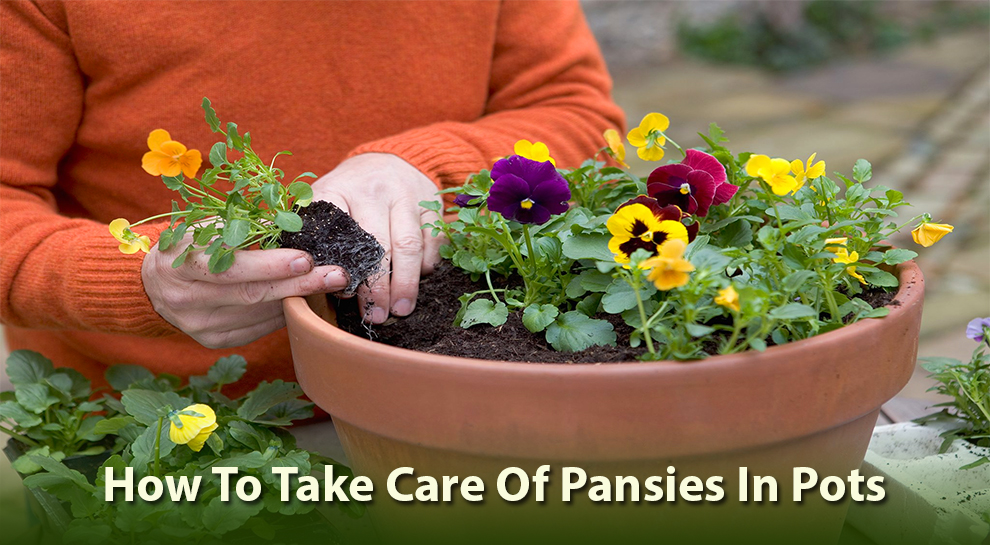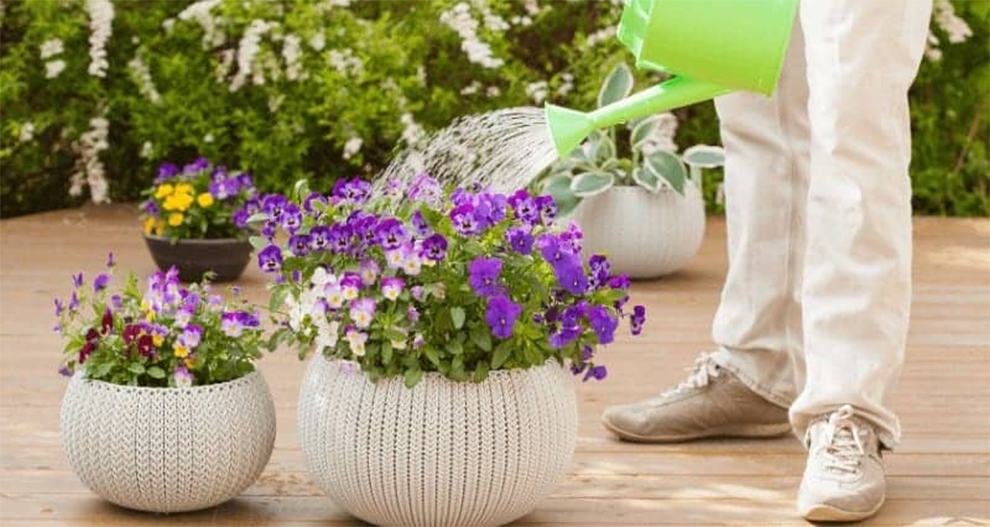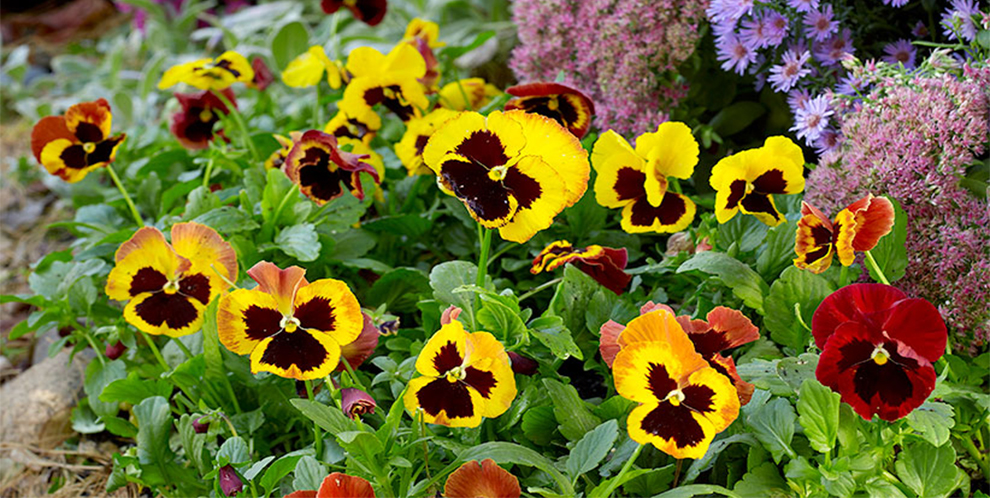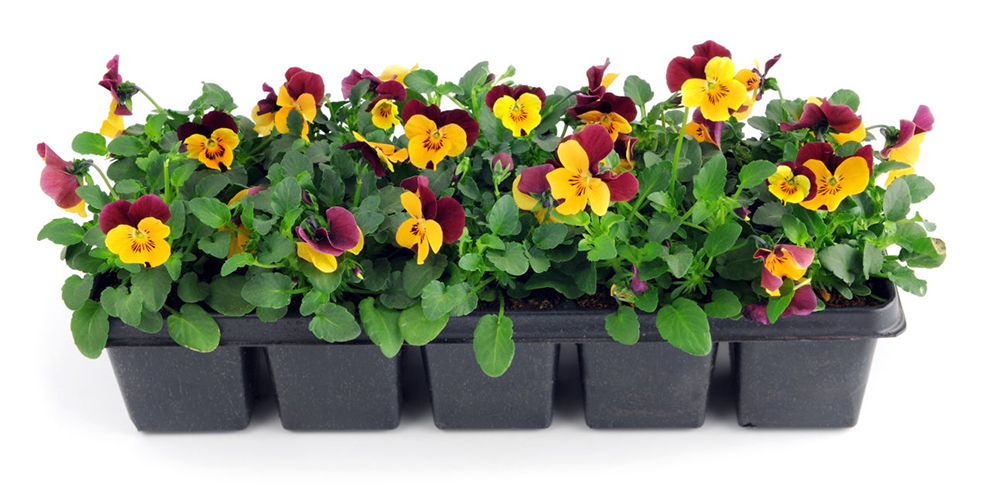How To Care For Pansies In Pots
Pansy flowers grow well in planters that are at least 6 inches in diameter and have drainage holes at the bottom to prevent waterlogging. Plant them in soil that is slightly acidic and does not collect water. Place the pot in partial sun and use a balanced feed time-to-time.

Pansies are cold-tolerant, colorful annuals usually planted in containers and pots for their vibrant blooms and easy care. However, to give them what they need, you must know how to care for pansies in pots.
Ideally, proper care for pansies in pots begins with choosing the correct type (plastic or terracotta) & size of pots (6”) with drainage holes. This is followed by the correct watering schedule, well-drained potting soil, partial sunlight, balanced nutrient dose, and lastly ensuring proper spacing between plants.
Neglecting any one or more such factors may lead to wilted leaves, stunted growth, and lack of blossoms. Caring for pansies in pots is imperative for their strength, good health, longevity, and aesthetic value.
Pansies add color and beauty to any indoor or outdoor space. This guide will take you through everything you must know to care for pansies in pots. So let us start and address this in detail.
How To Take Care Of Pansies In Pots?
Pansies are low-maintenance plants, but you cannot leave them after planting and not care for them. Your plants will bloom and thrive if they get the proper care.
So, here are the care tips to follow when growing pansies:
A. Choosing the Right Container for Pansies
Selecting the correct container for pansies is vital for their growth and health. Here are some tips to bear in mind:
1. Material: Select a container composed of lightweight and durable materials, such as terracotta and plastic. Do not use metal containers, as they get very hot in the sun. Further, avoid porous materials like unglazed terra cotta, as they may also dry out quickly.
2. Size: Pick a container about six inches deep and wide, ensuring adequate room for pansies to grow and spread. Overcrowding usually stunts the ground and lowers the number of blooms.
3. Drainage hole: Ensure the container has drainage holes at the bottom. It prevents the water from pooling or causing root rot. If the container does not have holes, you can drill some yourself or add a gravel layer at the bottom to boost drainage.
4. The number of plants: Ideally, you must plant one pansy per container or two if the container is big enough and has good drainage. Pansies require healthy roots and space to grow.
B. Potting mix for pansies in pots
Here are some tips for selecting the right potting mix for pansies:
- Well-draining: Pick a well-draining potting mix to prevent water from collecting at the container’s bottom and causing root rot. Look for a mixture that has vermiculite, perlite, or coarse sand.
- Organic matter: Pansies cherish a slightly acidic soil with ample organic matter. So, look for a potting mix with well-rotted manure, compost, and peat moss.
- Nutrients: Select a potting mix that has nutrients like phosphorous, potassium, and nitrogen. Add slow-release plant food to the mix for extra nutrients across the growing season.
- Do not use garden soil in the pots: It usually reduces drainage and becomes compacted. Further, garden soil has diseases and weed seeds that can harm your pansies.
C. How often should I water potted pansies?

The watering frequency depends on several factors for potted plants, such as container size, weather conditions, and soil type. Here are some tips that can help with watering potted pansies:
1. Inspect the soil moisture: Stick your finger about an inch into the soil to check the moisture level. If the soil feels dry, you must water it. If the soil is moist, you can wait a day or two before watering.
2. Do not overwater: Pansies like moist soil. However, overwatering can result in root rot and other issues. Water only when the soil feels dry to the touch.
3. Water deeply: When you water, do it deeply to encourage strong root growth. Keep watering until you see water draining from the container’s bottom.
4. Adjust for the weather: The plant might need more frequent watering during dry and hot weather to prevent the soil from drying out. During rainy or cooler weather, consider watering less.
So, on average water pansies once a week. If you ignore how to care for pansies in pots and do not consider their watering needs, your plants won’t thrive.
But be careful with the soil moisture and adjust the watering frequency as required based on the soil type and weather conditions.
D. How do you fertilize potted pansies?
Feeding pansies is a crucial aspect of their health and growth. Here are some beneficial tips to feed your potted pansies:
1. Select a balanced plant food for pansies: Look for a pansy fertilizer with balanced potassium, phosphorous, and nitrogen, such as the 10-10-10 or 20-20-20 fertilizer. Do not use a fertilizer with a high nitrogen level, as this will trigger more leafy growth at the expense of the blooms.
2. Fertilize regularly: Pansies in pots benefit from regular feeding every two to three weeks across the growing season. So, follow the manufacturer’s guidelines for the frequency and amount of application.
3. Apply to the moist soil: Water the soil well before applying fertilizer. It helps prevent root burning. Apply the feed to the soil around the plant’s base and not on the flowers or leaves.
4. Opt for a slow-release fertilizer: It is a convenient pick for potted pansies, as they ensure a steady nutrient supply over time. It is best to opt for a slow-release feed, exquisitely formulated for the flowering plants.
So, regular feeding with balanced plant food helps promote healthy growth and abundant blooms in potted pansies.
E. How much sun do potted pansies need?

Pansies need moderate sun to grow and bloom. Here are some guidelines to give your potted plants the needed sunlight:
1. Partial sun: Pansies cherish partial sun, implying that they seek about four to six hours of sun daily. It is typically in the late afternoon or morning when the sun is not very intense.
2. Shade in hot weather: When the temperature is hot, pansies can benefit from shade, especially during the hottest times. It helps avoid scorching and wilting. A location-filtered or dappled shade works best.
3. Inspect for signs of too much sun: Pansies can suffer from too much sun. It can cause the leaves to wilt and turn yellow. If you notice these signs, you must move your plant to a shadier spot or provide some shade with an umbrella or canopy.
4. Rotate the pot: To ensure even sun exposure, rotate the pot every few days to prevent pansies from leaning or unevenly growing towards the sun.
F. What temperature do pansies tolerate?
Pansies are typically cool-season plants and cherish moderate temperatures. Understanding what temperature works for your plant is also crucial if you want to know how to take care of pansies in a pot.
Here are some temperature considerations to care for your potted pansies.
1. Optimal temperature range: Pansies thrive between 45 and 65 °F (7-18°C). Anything above 75°F (24°C) can cause the plants to wilt, and temperatures below 32°F (0°C) can damage or kill them.
2. Shield them from extreme temperatures: People who reside in areas with extreme temperatures must take steps to protect their potted pansies by moving them indoors during frost or heat waves.
Alternatively, you can use frost blankets or shade clothes to shield them against extreme temperatures.
3. Location considerations: Consider the space’s microclimate when picking a location for your potted plants. For instance, a south-facing balcony may be too hot for pansies in the summer, while a north-facing area may not receive enough sun during winter.
4. Watering considerations: Potted pansies may need more frequent watering in hot weather to prevent the soil from drying out. Be careful not to overwater in cold weather, as the cold temperature can slow down the plant’s metabolism, making it more susceptible to root rot.
So maintaining a moderate between 45-65°F (7-18°C) is ideal for potted pansies. Protecting them from extreme temperatures and adjusting watering frequency as needed can help keep them healthy and thriving.
G. How to deadhead pansies in pots?

Deadheading or removing the spent blooms is imperative for encouraging new growth and prolonging the blooming period of potted pansies. This is how to look after pansies in a pot after they have bloomed.
Here are some steps to deadhead pansies in pots:
1. Identify the spent blooms: Look for the flowers that have turned brown or wilting, and gently grasp the stem below the flower head.
2. Pinch or snip the stem: With your pruning shears or fingers, snip or pinch the stem just below the flower head, being careful not to damage the surrounding foliage.
3. Discard the spent blooms: After removing the dead flowers, discard them in a trash can or compost bin.
4. Repeat as needed: Check the potted pansies regularly for spent blooms and deadheads as required to motivate new growth and prolong the blooming period.
Related: How long do pansies last?
Pest and Disease Management For Potted Pansies
Potted pansies are usually resistant to most diseases and pests. However, some issues can still affect the plant. Here are some disease and pest management tips for your potted pansies:
1. Monitor regularly: Check your potted pansies for signs of diseases or pests, such as wilting, discoloration, or leaf holes.
2. Ensure good air circulation to prevent moisture build-up, which may result in fungal diseases. Ensure your pansies have ample space between them to avoid overcrowding in the pot.
3. Water well: Overcrowding might result in root rot and other diseases. So water the pansies properly and deeply when the top inch feels dry.
4. Remove all infected plants: Whenever you notice signs of diseases or pests, remove the infected plants and dispose of them in a sealed plastic bag to prevent the problem from spreading to other plants.
5. Use home remedies
If you prefer natural remedies, use neem oil or insecticidal soap to control pests, and use a baking soda or copper fungicide spray for fungal diseases.
6. Consider preventative treatments
You can also use preventative treatments, such as applying a layer of mulch around the base of your pansies to prevent fungal spores from splashing onto the leaves.
How To Care For Potted Pansies In Winter?
Pansies are cool-season plants that can endure mild winters, making them an excellent choice for potted plants in cooler climates.
Here are some tips for caring for potted plants in winter:
1. Choose cold-hardy varieties: When selecting pansies for winter pots, choose cold-hardy pansy varieties that can withstand freezing temperatures and harsh winter conditions.
2. Keep the soil moist: Water your pansies regularly to keep the soil moist but not waterlogged. During the winter, you may need to water less frequently than in the summer.
3. Provide adequate drainage: Ensure that your pots have drainage to prevent water from pooling at the bottom, which can lead to root rot.
4. Protect from extreme temperatures: In areas with extremely cold temperatures, protect your pansies by moving them to a protected area, such as a covered porch or garage. You can also use frost blankets or burlap to protect them from freezing temperatures and harsh winds.
5. Fertilize sparingly: During the winter, pansies are not actively growing and do not require as much fertilizer as during the growing season. If you do fertilize, use a low-nitrogen, phosphorous-rich fertilizer.
6. Prune as needed: If your pansies become leggy or overgrown, prune them back to encourage new growth and maintain a compact shape.
